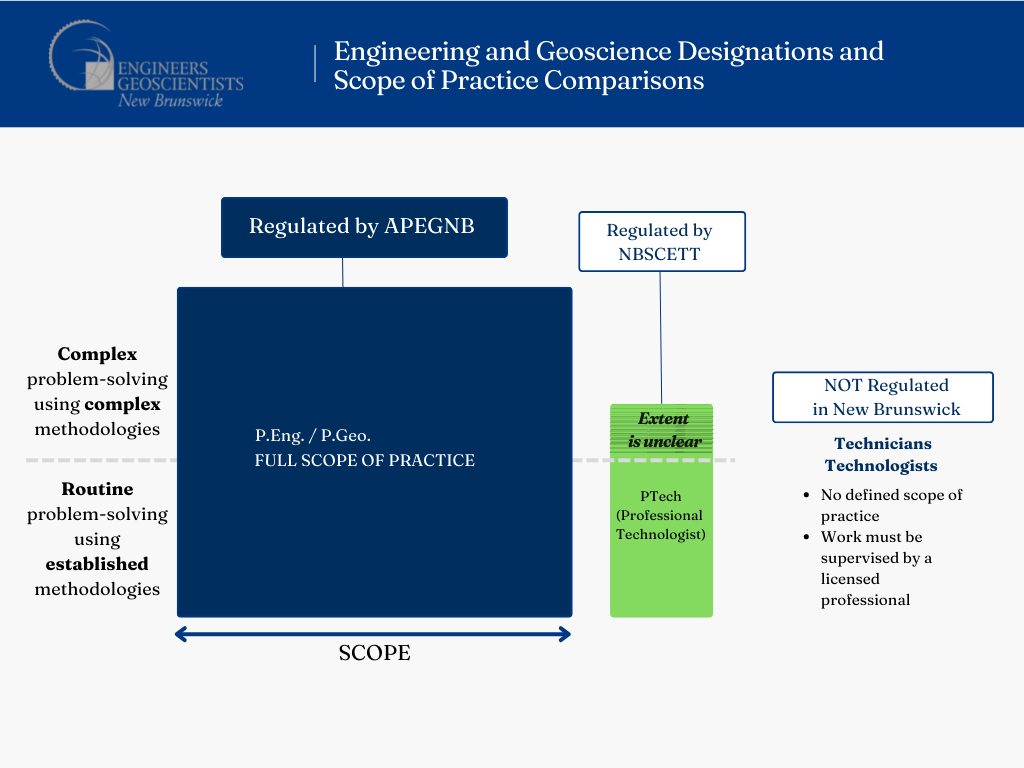What do I need to understand about these amendments?
APEGNB registrants are right to have questions about the implications of Bill 119, the legislation that resulted in recent amendments to the Engineering Technology Act.
As a result of APEGNB’s advocacy efforts, the final amendments passed into law significantly limit the scope of practice NBSCETT members are allowed to do under law and specify which tasks a certified engineering technologist or technicians may carry out.
Additionally, the amendments clarify that individuals who identify themselves as certified engineering technologists or technicians must register accordingly with NBSCETT.
These are key concessions, backed by APEGNB, to the originally proposed amendments which would have infringed more directly on activities described in the Engineering and Geoscience Professions Act.
What does an amended Engineering Technology Act mean for me?
The Engineering and Geoscience Professions Act, which governs the Association of Engineers and Geoscientists of New Brunswick, defines the practice of professional engineering as:
“… any act of planning, designing, composing, evaluating, advising, reporting, directing or supervising that requires the application of engineering principles and concerns the safeguarding of life, health, property, economic interests, the public welfare or the environment, or the managing of any such act.”
The practice of engineering technology is defined by the amended Engineering Technology Act as:
(b) with respect to certified engineering technologists, the carrying out of complex analytical work and practices in specialized portions of applied science and engineering technology, within codes, standards and generally recognized procedures and practices based on a comprehensive understanding of a specific technology including in design, production, marketing, testing, quality control, estimation, surveying, inspection, diagnostic evaluation, supervision, management, technical sales and teaching;
While the amendments now define the tasks engineering technologists and technicians may perform, it does not mean they must do them, nor that they should do them unsupervised. Most significantly, the inclusion of the limiting clause “specialized portions of applied science and engineering technology, within codes, standards and generally recognized procedures and practices.”
This serves to bracket the sort of work that can engineering technologists can do and establishes it into law. This represents a major concession over the earlier-proposed amendments which appeared to permit a larger scope of practice for NBSCETT members.
Despite this achievement, APEGNB continues to be concerned about ambiguity and overlap between how two acts describe the types of work they govern.

What happens next?
Technicians and technologists are vital members of engineering teams in New Brunswick but oversight by a professional engineer who takes responsibility for the work remains paramount for keeping the public safe.
The APEGNB analysis has concluded the overlap described may require a legal challenge to resolve any future disputes or claims against this, which is something the association warned legislators of during the debate over Bill 119.
APEGNB administration stands ready to engage in such matters, pending receipt of a complaint that is consistent with these concerns.
For registrants, it is important to be vigilant for work being conducted by people who are not members of APEGNB involves the application of engineering principles as described in our Act and highlighted above.
If you become aware of such a concern, contact CEO and Registrar, Lia Daborn as soon as possible, and with as many details as you have.
From there, APEGNB will lead a resolution process that we hope will bring greater clarity and direction to the future of engineering and geoscience in New Brunswick.
Your attention to this matter is consistent with APEGNB’s core mandate: protecting the public interest through the enforcement of high professional and ethical expectations, codes of conduct, and administering regulatory processes to ensure the protection of New Brunswickers.
